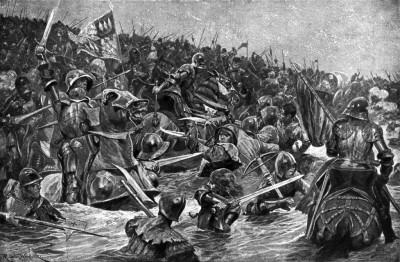The Battle of Towton

'The Battle of Towton' (29 March 1461), in which the Yorkists slaughtered the Lancastrians, by Richard Caton Woodville (1825-1855).
Associated places
Dates
29th March 1461Description
Following the Battle of Wakefield, the House of York was seemingly without a figurehead. Their cause was elevated on 2 February when Edward, earl of March, the son and heir of the duke of York, defeated the Lancastrian army in a stunning victory at the Battle of Mortimer’s Cross. Even the earl of Warwick’s loss at the Second Battle of St. Albans two weeks later could not dim Edward’s victory. He marched upon London in early March and was proclaimed king on 4 March 1461.
Edward and Warwick, joined by Warwick’s uncle Lord Fauconberg, moved north prepared to meet the queen and her supporters. Battle commenced on Palm Sunday, 29 March 1461 at Towton, North Yorkshire and was fought amidst the blistering cold and snow. Taking advantage of the wind, the Yorkists used their archers to fire deep into the Lancastrian lines. Blinded by the snow, the Lancastrians were unable to respond and instead instigated indecisive hand-to-hand combat. York took the advantage with the arrival more troops under the duke of Norfolk. The Lancastrians fled the field, either drowning in the neighboring Cock River or being cut down from behind by over-zealous Yorkist troops.
Chroniclers contend that the fighting lasted longer than 10 hours though modern research points to a more likely timeframe of three. Regardless, it ended as the bloodiest battle on English soil. Among the Lancastrian dead were Henry Percy, 3rd earl of Northumberland and his younger brother Richard Neville who had helped instigate the Percy-Neville feud. At the battle’s end, England had a new king: Edward IV.

